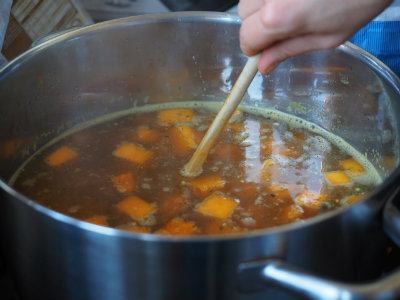Broth, Bone Broth Or Stock: Are They The Same?
The differences between bone broths and chicken stocks are a matter of where each falls on a spectrum rather than a clear and distinct difference between the two. Bone broths have become common as a result of the prevalence of the Paleo diet. The diet trend has triggered an argument about the differences between the two. The hype about bone broths is fueled by the claim that it is more nutritious than a pure broth and stock. Many scientists have refuted this claim and have argued that even if a bone broth is nutritious; its health benefits have been overly exaggerated. Also, this food is not new as it has been around for many years and was sold in restaurants as far back as the 18th Century.
If you ask most Americans today whether there is a difference between chicken stock and bone broth, you will find  out that most believe the two are largely the same while others think they have a slight difference. The differences may come in the method of preparation, individual ingredients or their constitution. For the most part, however, it is a matter of opinion. Stocks and broths are prepared by various cultures all over the world and hence, there will be a difference.
out that most believe the two are largely the same while others think they have a slight difference. The differences may come in the method of preparation, individual ingredients or their constitution. For the most part, however, it is a matter of opinion. Stocks and broths are prepared by various cultures all over the world and hence, there will be a difference.
Bones Or Meat For The Broth?
Stocks and broths have distinct characteristics and definitions. The stock has to be prepared using bones. There are many flavors embedded in bones and their marrows. The bones are boiled and simmered for a long time to extract these juices.
On the contrary, broth is the liquid in which any kind of meat has been cooked. It may be fish, beef, mutton or chicken. It is very nutritious but does not necessarily include any bones. If the meat were to be stripped off the bones and prepared that way, the liquid would be considered broth. Bone broths, on the other hand, are a combination of both stocks and broths. Therefore, they allow you to enjoy the benefits of both broths and stocks.
Preparation Methods
Another minor difference between stocks and broths comes about in the way they are commonly made. In most cases, the stock is made from bones. First, these bones are usually roasted. Then they will simmer for hours. Some people will leave them to simmer for as long as twelve hours. They will cook for a short period after that, and the liquid is ready.
Broths, on the other hand, are never simmered for long. Meat simmered in water for a few hours is often enough to prepare a broth. A bone broth is prepared using both bones and meat. The bones are first roasted and then simmered for long hours (between 12 -24). Bones that have meat attached can also be used to make bone broths.
Flavor And Appearance
A broth and a chicken stock will differ in taste and appearance. Due to the bones included in making stock, stocks will often be thick and have a darker color than broths which will be light in viscosity and appearance. Moreover, you will probably like the taste of a broth over the taste of a stock. A broth will excite your pallet more since it is lighter than stocks and you will have a taste that can be easily distinguished. Therefore, a bone broth has both good a flavor and a dark appearance since it is a blend of the two.
What About Nutrients?
Bones and their marrows have many constituents. Among them are gelatin and other dense nutrients. Therefore, stocks have a lot more in nutrient quality than a broth. The extended periods of simmering will break down the collagen in the bones releasing nutrients and making them more digestible when ingested. Broths, on the other hand, are less nutritious. Therefore one can have stock which is very nutritious but not very delicious or have broth that tastes good but does not strengthen your body as much. It is a trade-off between taste and nutrition. Thus, it is apt to say that bone broths have both nutrition and a delicious taste.
Ingredients Used
Another difference between stock and broth may appear due to the ingredients contained in the two. Vegetables can be included in either one but are often included in broths. Hence, it is called a broth if it has vegetables such as carrots or tomatoes. The vegetables can add to the thickness of broth. However, if one prefers, they could add vegetables to a stock i.e. prepared with bones although it may be very thick. Seasoning is another key factor. Usually, it is broths that require seasoning and they can be consumed as a meal on their own while stocks do not require it. Nevertheless, ingredients used are often a matter of personal preference than a matter of law. A bone broth is also seasoned since it is partly a broth.
As can be seen above, there are few differences between the two and where there are differences it is a minuscule matter or a matter of taste and preference. The difference likely lies with you and how you would like the dish prepared. You can call it a bone broth or chicken stock as long as you can enjoy it and get the health benefits they both offer.






